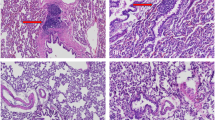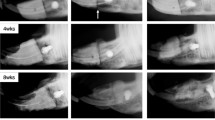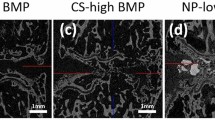Abstract
The direct, local, administration of adenovirus carrying human BMP-2 cDNA (Ad.BMP-2) heals critical-sized femoral bone defects in rabbit and rat models. However, the outcome is suboptimal and the technology needs to provide a more reliable and uniform outcome. To this end, we investigated whether the timing of Ad.BMP-2 administration influenced the formation of mineralized tissue within the defect. Critical-sized defects were created in the femora of 28 Sprague–Dawley rats. Animals were injected intralesionally with a single, percutaneous injection of Ad.BMP-2 (4 × 108 plaque-forming units) either intraoperatively (day 0) or 24 h (day 1), 5 days or 10 days after surgery. The femora were evaluated 8 weeks after surgery by X-ray, microcomputed tomography, dual-energy X-ray absorptiometry and biomechanical testing. The incidence of radiological union was markedly increased when administration of Ad.BMP-2 was delayed until days 5 and 10, at which point 86% of the defects healed. These time points also provided greater bone mineral content within the defect site and improved the average mechanical strength of the healed bone. Thus, delaying the injection of Ad.BMP-2 until 5 or 10 days after surgery enables a greater percentage of critical-sized, segmental defects to achieve radiological union, producing a repair tissue with enhanced mineralization and greater mechanical strength.
This is a preview of subscription content, access via your institution
Access options
Subscribe to this journal
Receive 12 print issues and online access
$259.00 per year
only $21.58 per issue
Buy this article
- Purchase on Springer Link
- Instant access to full article PDF
Prices may be subject to local taxes which are calculated during checkout







Similar content being viewed by others
References
Evans CH, Ghivizzani SC, Herndon JH, Robbins PD . Gene therapy for the treatment of musculoskeletal diseases. J Am Acad Orthop Surg 2005; 13: 230–242.
Betz O, Vrahas M, Baltzer A, Lieberman J, Robbins P, Evans C . Gene transfer approaches to enhancing bone healing. In: Lieberman JR, Friedlaender GE (eds). Bone Regeneration and Repair. Humana Press: Totowa, 2004, pp. 157–168.
Bertone AL, Pittman DD, Bouxsein ML, Li J, Clancy B, Seeherman HJ . Adenoviral-mediated transfer of human BMP-6 gene accelerates healing in a rabbit ulnar osteotomy model. J Orthop Res 2004; 22: 1261–1270.
Krebsbach PH, Gu K, Franceschi RT, Rutherford RB . Gene therapy-directed osteogenesis: BMP-7-transduced human fibroblasts form bone in vivo. Hum Gene Ther 2000; 11: 1201–1210.
Lee JY, Musgrave D, Pelinkovic D, Fukushima K, Cummins J, Usas A et al. Effect of bone morphogenetic protein-2-expressing muscle-derived cells on healing of critical-sized bone defects in mice. J Bone Joint Surg Am 2001; 83-A: 1032–1039.
Lieberman JR, Daluiski A, Stevenson S, Wu L, McAllister P, Lee YP et al. The effect of regional gene therapy with bone morphogenetic protein-2-producing bone-marrow cells on the repair of segmental femoral defects in rats. J Bone Joint Surg Am 1999; 81: 905–917.
Wright V, Peng H, Usas A, Young B, Gearhart B, Cummins J et al. BMP4-expressing muscle-derived stem cells differentiate into osteogenic lineage and improve bone healing in immunocompetent mice. Mol Ther 2002; 6: 169–178.
Musgrave DS, Pruchnic R, Bosch P, Ziran BH, Whalen J, Huard J . Human skeletal muscle cells in ex vivo gene therapy to deliver bone morphogenetic protein-2. J Bone Joint Surg Br 2002; 84: 120–127.
Li JZ, Hankins GR, Kao C, Li H, Kammauff J, Helm GA . Osteogenesis in rats induced by a novel recombinant helper-dependent bone morphogenetic protein-9 (BMP-9) adenovirus. J Gene Med 2003; 5: 748–756.
Betz OB, Betz VM, Nazarian A, Pilapil CG, Vrahas MS, Bouxsein ML et al. Direct percutaneous gene delivery to enhance healing of segmental bone defects. J Bone Joint Surg Am 2006; 88: 355–365.
Baltzer AW, Lattermann C, Whalen JD, Wooley P, Weiss K, Grimm M et al. Genetic enhancement of fracture repair: healing of an experimental segmental defect by adenoviral transfer of the BMP-2 gene. Gene Therapy 2000; 7: 734–739.
Egermann M, Schneider E, Evans CH, Baltzer AW . The potential of gene therapy for fracture healing in osteoporosis. Osteoporos Int 2005; 16: S120–S128.
Egermann M, Baltzer AW, Adamaszek S, Evans C, Robbins P, Schneider E et al. Direct adenoviral transfer of bone morphogenetic protein-2 cDNA enhances fracture healing in osteoporotic sheep. Hum Gene Ther 2006; 17: 507–517.
Bertone AL, Pittman DD, Bouxsein M, Li J, Clancy B, Seeherman H . Adenoviral-mediated transfer of hBMP-6 gene accelerates osteotomy repair and return of bone mechanical properties. Transactions of the Orthopaedic Research Society 2002; 27: (Abstr. 0279).
Ito T, Tokunaga K, Maruyama H, Kawashima H, Kitahara H, Horikoshi T et al. Coxsackievirus and adenovirus receptor (CAR)-positive immature osteoblasts as targets of adenovirus-mediated gene transfer for fracture healing. Gene Therapy 2003; 10: 1623–1628.
Baltzer AW, Lattermann C, Whalen JD, Braunstein S, Robbins PD, Evans CH . A gene therapy approach to accelerating bone healing. Evaluation of gene expression in a New Zealand white rabbit model. Knee Sur Sports Traumatol Arthrosc 1999; 7: 197–202.
Seeherman H, Li R, Bouxsein M, Kim H, Li XJ, Smith-Adaline EA et al. rhBMP-2/calcium phosphate matrix accelerates osteotomy-site healing in a nonhuman primate model at multiple treatment times and concentrations. J Bone Joint Surg Am 2006; 88: 144–160.
Hardy S, Kitamura M, Harris-Stansil T, Dai Y, Phipps ML . Construction of adenovirus vectors through Cre-lox recombination. J Virol 1997; 71: 1842–1849.
Palmer GD, Gouze E, Gouze JN, Betz OB, Evans CH, Ghivizzani SC . Gene transfer to articular chondrocytes with recombinant adenovirus. Methods Mol Biol 2003; 215: 235–246.
Einhorn TA, Lane JM, Burstein AH, Kopman CR, Vigorita VJ . The healing of segmental bone defects induced by demineralized bone matrix. A radiographic and biomechanical study. J Bone Joint Surg Am 1984; 66: 274–279.
Yasko AW, Lane JM, Fellinger EJ, Rosen V, Wozney JM, Wang EA . The healing of segmental bone defects, induced by recombinant human bone morphogenetic protein (rhBMP-2). A radiographic, histological, and biomechanical study in rats. J Bone Joint Surg Am 1992; 74: 659–670.
Alexander JM, Bab I, Fish S, Muller R, Uchiyama T, Gronowicz G et al. Human parathyroid hormone 1-34 reverses bone loss in ovariectomized mice. J Bone Miner Res 2001; 16: 1665–1673.
Li G, Bouxsein ML, Luppen C, Li XJ, Wood M, Seeherman HJ et al. Bone consolidation is enhanced by rhBMP-2 in a rabbit model of distraction osteogenesis. J Orthop Res 2002; 20: 779–788.
Acknowledgements
This work was supported by grants from the National Institutes of Health (Grant No. AR 050243-02) and Zimmer Inc. The AO Research Institute in Davos supplied the external fixators used in this study.
Author information
Authors and Affiliations
Corresponding author
Rights and permissions
About this article
Cite this article
Betz, O., Betz, V., Nazarian, A. et al. Delayed administration of adenoviral BMP-2 vector improves the formation of bone in osseous defects. Gene Ther 14, 1039–1044 (2007). https://doi.org/10.1038/sj.gt.3302956
Received:
Revised:
Accepted:
Published:
Issue Date:
DOI: https://doi.org/10.1038/sj.gt.3302956
Keywords
This article is cited by
-
The role of VEGF and BMP-2 in stimulation of bone healing with using hybrid bio-composite scaffolds coated implants in animal model
Bulletin of the National Research Centre (2020)
-
Current Trends in Viral Gene Therapy for Human Orthopaedic Regenerative Medicine
Tissue Engineering and Regenerative Medicine (2019)
-
Gene therapy approaches to regenerating the musculoskeletal system
Nature Reviews Rheumatology (2015)
-
Using genes to facilitate the endogenous repair and regeneration of orthopaedic tissues
International Orthopaedics (2014)
-
Repair of large segmental bone defects: BMP-2 gene activated muscle grafts vs. autologous bone grafting
BMC Biotechnology (2013)



